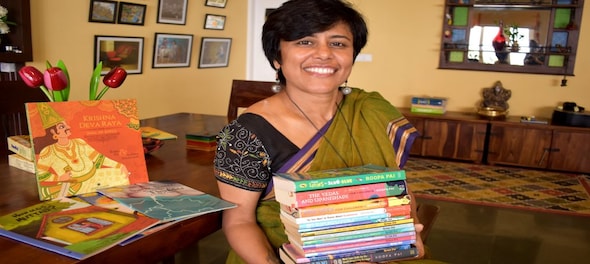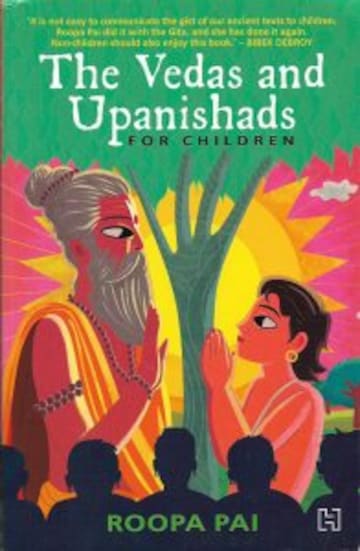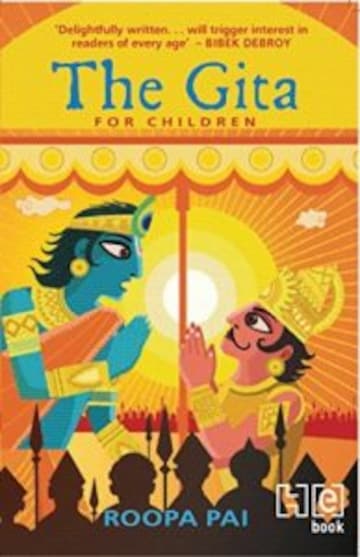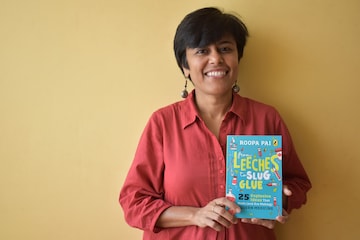
A computer engineer from Bengaluru, married to an IIT-IIM graduate and having travelled and lived around the world with him – from Delhi and Mumbai to New York, London and Orlando – the last thing Roopa Pai would have imagined in her youth was becoming an authority on the Bhagavad Gita, Vedas and Upanishads, and writing books about them.
But that indeed is where life has led her, and as usually happens when you walk with gods, there is a dollop of divine support and mystical events along the way. “I grew up reading Enid Blyton, and imagined that only British children had a good childhood and my own – with full family picnics with lemon rice instead of scones – was somehow sucky,” laughs the 48-year-old children’s books author in a Bengaluru coffee shop, where we meet for the first time.
 Upnishads for kids
Upnishads for kids“Then I came across Target , and loved it. I began to dream of creating a parallel universe which wasn’t India but where all the references were Indian, and something Indian kids could relate to,” narrates Roopa, who first began writing books for children 26 years ago.
It so happened that a books commissioning editor at Hachette, Vatsala Kaul, was all set to play Krishna to Roopa’s Arjuna. “She pulls my chariot,” jokes Roopa, narrating how, about a decade ago, Vatsala convinced Roopa to write an eight-book series of science fiction picture books for children, called Taranauts, and Roopa was able to fulfil her dream of an alternative desi universe, replete with ‘samchoris’ (samosas + kachoris) and a villain called Morphoroop (roop is Hindi for appearance).
After the four-year project ended, the scientific-minded Roopa wrote an entertaining science book for kids, What If Earth Stopped Spinning? (2014) And then Vatsala asked her a question which went on to change her life.
“What about a Gita for children?”
It was the last thing Roopa would have imagined. “Who said the Gita is for children?” she asked her editor. “And besides, what credibility do I have in this matter?” She continued making excuses for six months until Vatsala finally asked her to get a copy of the Gita for herself, and check it out.
“I went to my husband’s knowledgeable aunt for help. She explained it all to me with mind-maps for each chapter,” recalls Roopa, who is mother of a 22-year-old daughter and a 17-year-old son. “By the end of it, I realised the Gita is a conversation between two best friends. Sure, I can explain it to kids.”
Roopa became hooked to the sacred Hindu scripture, and developed a sense of healthy awe. Blessed with the ability to make difficult subjects easy-to-understand for kids, she found the writing process joyful and uplifting. But unsure about herself even at the end, she had the manuscript sent to Indian economist, author, bureaucrat and Indologist Bibek Debroy. “Within days, he returned it saying, ‘This must be published.’ I sighed with relief,” she says. Coming from a man who had translated the unabridged Mahabharata from Sanskrit to English in 10 volumes and 2.25 million words, she decided her little effort may not have been so bad after all.
It was rather good, in fact. The Gita for Children went on to sell over 75,000 copies, and continues to be on top of the charts for children’s books four years down the line.
 The Gita for children
The Gita for childrenAfter a couple of more children’s books, one on economics, Roopa went on to write The Vedas and Upanishads for Children, which came out earlier this year. Putting heavy, esoteric philosophy into bite-sized bits of light-hearted wisdom is surely a gift bestowed on her by the millions of Hindu gods in the heavens, and even adults keep the book handy for divine instruction on days they face earthly dilemmas.
“It’s the best compliment ever that adults too love reading these books,” smiles Roopa, who no doubt gets it often. “That’s my deepest desire – to have parents and kids read these books together.”
Writing about duty, destiny and dharma has changed the knowledge-seeking Roopa in many ways. “I used to read crime thrillers earlier, now I’ve switched to spiritual books. I’ve started listening to spiritual discourses, especially by Swami Sarvapriyananda and Sri M, and now people send me videos and links that they think I will like. It’s a virtuous cycle, and it’s nothing I’ve ever done before,” she admits.
It has also changed her world view. “The Upanishads themselves leave so many things open-ended; the real essence is that they embrace multiple points of view. The only rule is that there are no rules – but that only makes it more difficult for each one must find the truth for herself. There are no shortcuts,” she says, dismissing modern-day debates on who the Aryans were.
“How does it matter? Those who are secure about the truth have no need to argue. Studying the scriptures has changed me. It’s made me less judgemental, and more at peace with diverse ideas and viewpoints. Instead, I keep asking myself, who am I?”
Mindfulness is a quality one must work on, avers Roopa, but it is one that also comes with a caveat. “Yes, it’s empowering to be aware of your thoughts and actions, but it’s also terrifying because now you must take responsibility for all the consequences as well,” she explains. Our religion is certainly not for the faint of heart.
 “I went to my husband’s knowledgeable aunt for help. She explained it all to me with mind-maps for each chapter,” recalls Roopa, who is mother of a 22-year-old daughter and a 17-year-old son. “By the end of it, I realised the Gita is a conversation between two best friends. Sure, I can explain it to kids.”
“I went to my husband’s knowledgeable aunt for help. She explained it all to me with mind-maps for each chapter,” recalls Roopa, who is mother of a 22-year-old daughter and a 17-year-old son. “By the end of it, I realised the Gita is a conversation between two best friends. Sure, I can explain it to kids.”Roopa shares that the most lasting relationship she has developed over the past five years is one with the god within. “The reflective life is a good thing to practise. Krishna says, keep practising – have 100 percent focus on your effort, and have zero percent expectation of the outcome. Arjuna is symbolic of the seeker and Krishna of his gut or his psychiatrist. You won’t trust your Krishna unless you have years of deep friendship with Him, and trust Him enough to place all dilemmas in His hands. If you live a reflective life, your dharma becomes clearer. The more you practise, the faster you find answers to life’s dilemmas,” says Roopa, who recommends Yuval Noah Harari’s books Sapiens and the hard-hitting 21 Lessons for the 21st Century to understand human motivations and behaviour.
 After a couple of more children’s books, one on economics, Roopa went on to write The Vedas and Upanishads for Children, which came out earlier this year.
After a couple of more children’s books, one on economics, Roopa went on to write The Vedas and Upanishads for Children, which came out earlier this year.Roopa's own new book, From Leeches to Slug Glue: 25 Explosive Ideas that Made (and Are Making) Modern Medicine (Puffin) takes her back to the world of science, narrating the history of medicine for kids. “I’m much more comfortable with kids than adults. The Indian publishing industry wants its authors to be performers; that’s not fair!” she complains jokingly.
I ask her what knowledge she’d want to leave her beloved child readers as legacy. She goes sombre for a moment. “Aham brahmasmi. You’re not a speck in the cosmos; you contain the entire cosmos within you. Don’t ever feel helpless. You can be god,” she says kindly. That’s a lesson even grownups need to hear.
First Published: Nov 8, 2019 1:14 PM IST
Check out our in-depth Market Coverage, Business News & get real-time Stock Market Updates on CNBC-TV18. Also, Watch our channels CNBC-TV18, CNBC Awaaz and CNBC Bajar Live on-the-go!


Prajwal Revanna's father in custody for alleged kidnapping and sexual abuse
May 4, 2024 7:53 PM
Delhi, Indore, Surat and Banswara — why these are the most challenging domains for Congress internally
May 4, 2024 1:53 PM
Congress nominee from Puri Lok Sabha seat withdraws, citing no funds from party
May 4, 2024 12:00 PM
Lok Sabha Polls '24 | Rahul Gandhi in Rae Bareli, why not Amethi
May 4, 2024 9:43 AM

